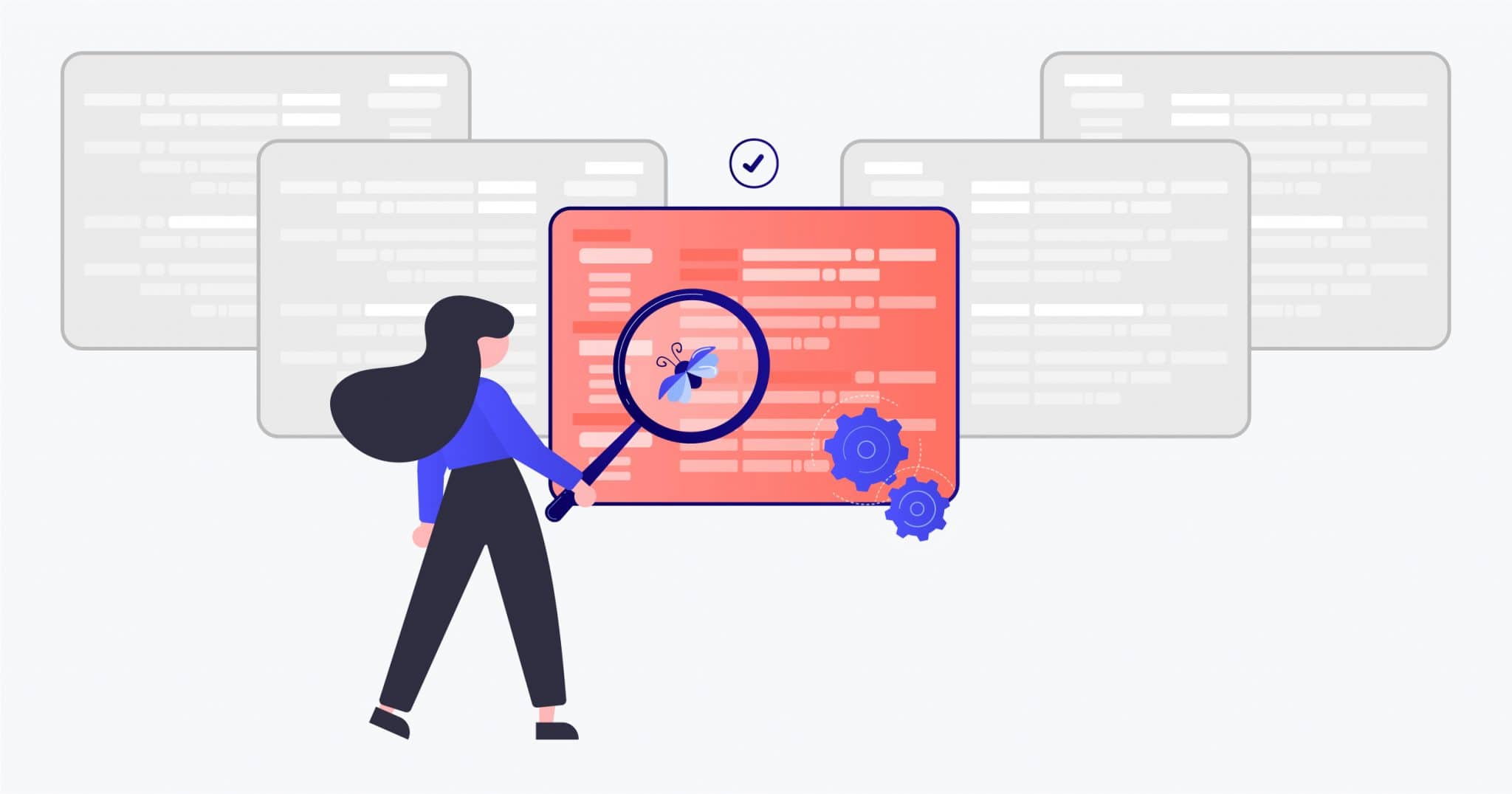With a test management tool, you can keep a complete track of testing activities, as well as visualize progress very easily. It facilitates teams to plan and write cases, execute them, log and assign defects, and generate different types of reports. It also allows you to monitor progress of all team members, which helps keep everyone on the same page. Choosing the right management testing tools can streamline your testing processes and improve overall efficiency.
Even a minor error in recording crucial project information can have disastrous consequences. Hence, to keep track of all of data, a control software is likely to work in your benefit and significantly pull up your testing game.
Therefore, we are here to make your lives easier by presenting to you a comprehensive list of the best test management tools. Our comprehensive tools list highlights the top solutions to help you decide the best fit for your team. All tools below are discussed in depth, with detailed pros and cons, to ease your decision-making process and ensure that you end up with the tool that best suits your needs.
1. Kualitee
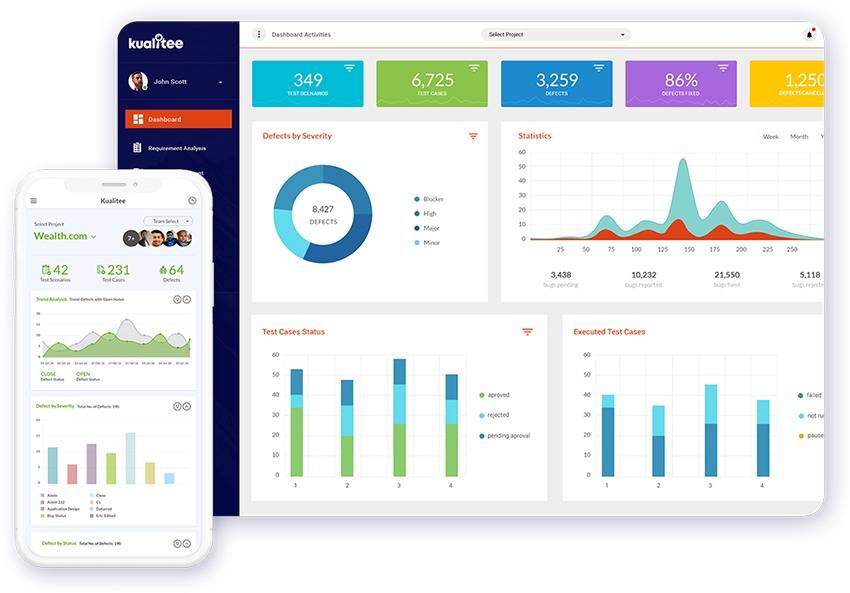
Kualitee is a very practical test management tool that helps you track and visualize all your testing from a single place. It gives complete traceability through easy linking between tests, executions and defects.
It has a user-friendly dashboard with stress-free testing KPI’s and metrics, all of which help you to streamline your testing process.
Kualitee is an ever-useful tool for using across multiple projects, as a result of its easy reusability and the functionality to replicate test cycles.
In addition to this, this QA testing tool provides seamless integration with tools such as Jira, Selenium, GitLab, and Asana.
Now, let us look further into this tool by weighing both its pros and cons—we repeat, we want to make your decision-making process easier!
Pros:
– Manage all your testing with complete traceability, test case management, issue tracking, and custom reporting, all from a single tool.
– Import and Export requirements.
– Facilitates building of test cases.
– Bugs detection.
– Allows you to make a hierarchical tree out of the cases and suites.
– Custom dashboards for managers, developers, and testers.
– Mobile app to view the latest insights, track team’s progress, log and assign bugs on the go.
– In-app customer support.
Cons:
– Limited language support for automated testing.
– Only allows imports in CSV format.
2. Qase

Qase is on Best Test Case Management Tools list and has a modern and minimalist GUI and features designed for QA and Dev teams.
The comprehensive range of features includes test case management, defect management, strategies, test runs with detailed documentation, a rich API, and webhooks.
Qase integrates with a variety of common problem trackers, including Jira, Redmine, and Trello. You can create a problem without exiting the program, and it will be instantly posted. When you want to be updated when they begin, Slack integration is helpful.
You will integrate with your automatic testing and post reports directly to the app using the REST API. Webhooks will assist you withbuilds in your continuous integration system.
Pros:
– Composing cases takes less time with shared steps.
– Your testing phase can be accelerated by using a smart wizard for a test cycle.
– Verify modifications to the model through a case review.
– Lets you assign test cases to your teammates and write a test plan.
– Good defect management.
Cons:
– Very few statistics and no option to add your own dashboards.
– Shared steps cannot be grouped according to subject or category.
3. TestCaseLab
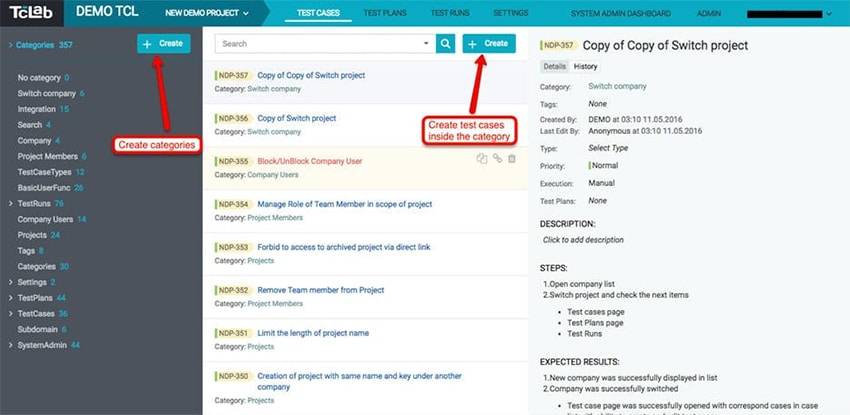
TestCaseLab helps you to keep track of the majority of tasks, such as designing cases, categorizing them, organizing them into schedules, beginning test runs, and submitting reports to Jira. The most basic package begins at $40 a month for 500 test cases, and there are no additional fees per user.
Pros:
– Users and projects are not regulated.
– Jira, Redmine, Pivotal Tracker, Asana, YouTrack, and Trello are all integrated.
– Test cases may be exported and imported.
– A wide range of case properties are available.
– Running of tests and assigning users.
– Results of test cases are recorded at each point of the test.
– Reporting/insights at a simple level.
– History record and activity stream.
– Synchronization in real-time.
Cons:
– Test plan is limited to one project.
– Little clarity between test cases and test runs which may cause confusion.
4. Testuff
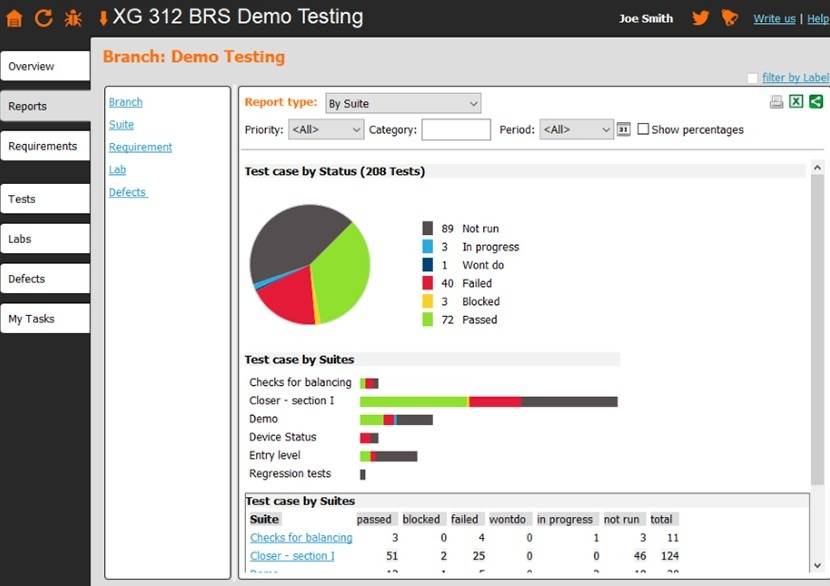
Testuff facilitates teams to report and handle a large number of tests, testers, programs, and defects. It is safe and has a fully backed-up environment. Projects, divisions, and structured suites can all be used to arrange tests in Testuff. Data from an Excel sheet can also be imported and exported.
Pros:
– Any number of bug trackers can be integrated.
– Twitter integration to interact with your colleagues.
– Add a video to the defect reports.
– Assign particular testers to specific tests.
– Use several labs to schedule a test cycle.
Cons:
– Only supports 12 users per session.
– A bit pricey.
5. Xray
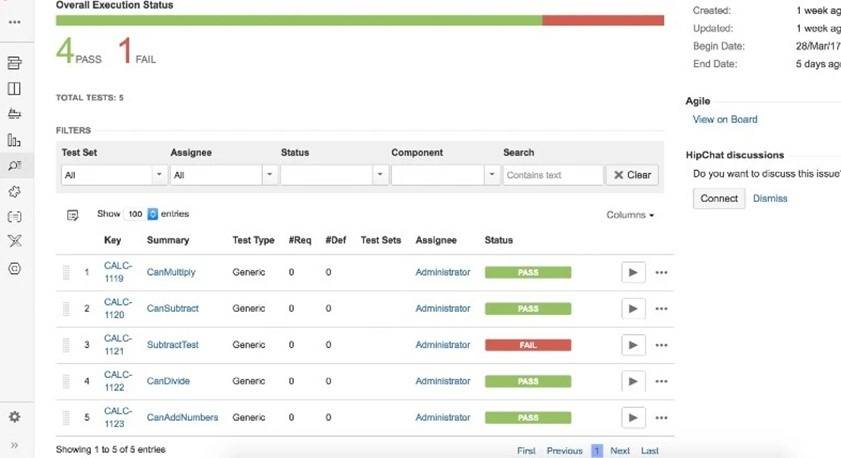
Xray is a full-featured tool that is placed within Jira and works within it. Its mission is to assist businesses in improving the consistency of their products through efficient and reliable research. They will prepare, conduct, and monitor their research with complete traceability of specifications.
Apart from JUnit, NUnit, Robot, and others, Xray supports both manual and automatic checks, including BDD using Cucumber. It includes the entire testing life cycle, including preparation, specification, flat or hierarchical test organization, implementation, and monitoring.
It accomplishes this by using unique Jira problem forms, allowing you to make good use of all Jira features, while also letting you coordinate features within the same project or through several projects with simple divisions..
Pros:
– Integration with continuous integration tools including Bamboo and Jenkins.
– Custom fields for each issue type.
– Ability to work logs in test execution cases.
– Xray issues can be assigned, with addition of and watchers.
Cons:
– Work is limited inside Jira.
– No feature to manage requirements or user stories.
6. TestMonitor
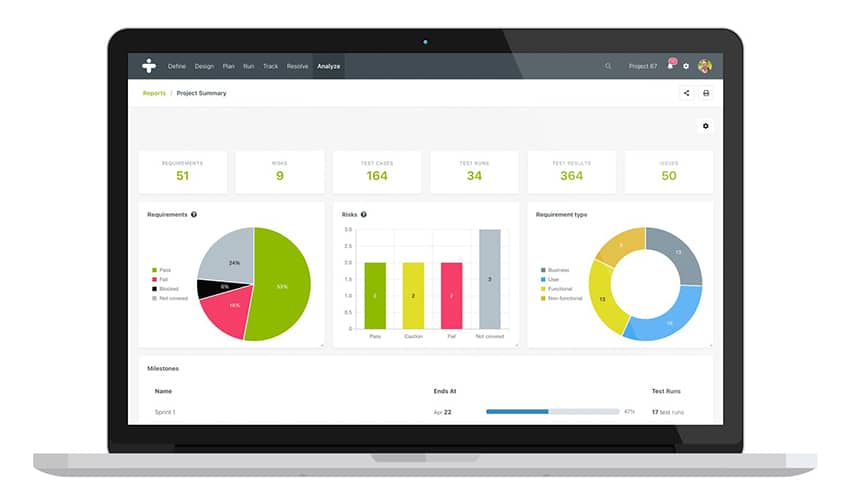
Test Monitor offers complete solutions for IT user acceptance testing. It supports features like test management, requirements, planning, running checks , results, resolving issues, and reporting. The tool has an integrated issue tracker with features like filters, prioritization, a full history trail, attachment handling, commenting, and time management. It has a structured testing approach with a streamlined process of tracking results. It is one of the best test case management tools, as it has you covered whether you’re installing commercial applications, developing a high-quality app, or if you just need some assistance with your project.
Pros:
– The approach is structured to make complex projects straightforward and comprehensible.
– It is easy to manage large amounts of cases as Tools have a test case editor that gets cases running in minutes.
– It is easy to prioritize test cases, analyze risks and get a grasp over the project’s outcome by using requirement specification.
– It is convenient to schedule sprints, releases, or iterations to organize test runs as you can use milestones to mark events for the team.
– The user interface can be used by all. You can execute runs at any place and time without requiring any prior experience.
– The tool allows tracking workload of the entire team with real-time status and progress reports for runs, cases, and issues.
– It integrates with Slack, Jira, and other software testing tools.
Cons:
– The system does not support all parts of the processes to be tested automatically. Scenarios have to be created manually.
– Adding print screens does not work when Java plug-ins are not up to date.
– It does not support mobile app testing.
– There is no SDK feature.
7. SpiraTest
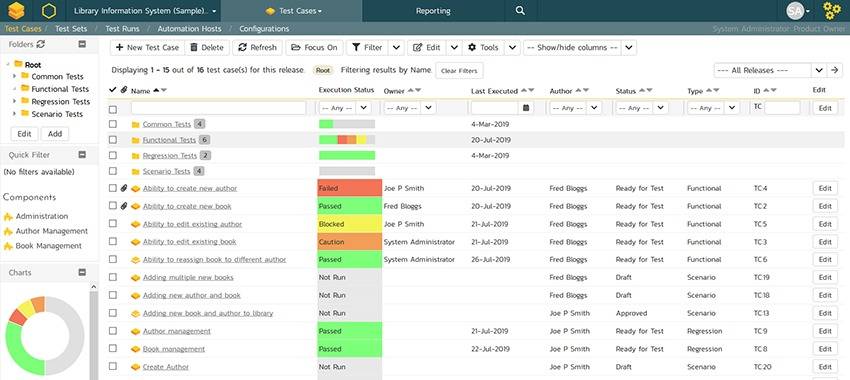
This is another popular tool in our best test management tools list. It has a plethora of useful features like project creation, assigning member role, creating plans and cases, requirement planning, runs, report generation, bug trackers, , seamless integrations, and so on. . All these features play a huge role in facilitating the process.
Pros:
– Well-developed testing solution with an affordable price model.
– Cloud-hosted version is also available.
– Less time is spent in creating custom fields and assigning numbers to cases, which increases efficiency.
Cons:
– Does not have many integration options.
– Interface can be improved,from a user perspective.
8. qTest
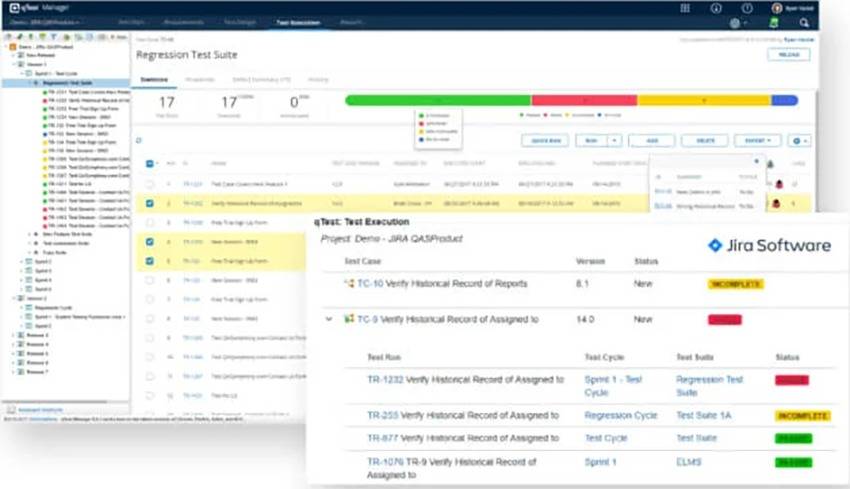
One of the most famous tools among the software testers is qTest, which is a product of Tricentis. This was developed with the aim of assisting the testers and the entire team during the development process. The majority of the testers believe that the interface is user-friendly and simple.
Its main functions include:
- Creating a test plan. This includes what, how, and when scenarios and who can test the functionality.
- Explaining, bringing in, and distributing the requirements.
- Various report alternatives for these requirements.
- Test design – explaining the main test cases.
Pros:
– Manage end-to-end testing , from requirements to cases and , execution, issue tracking tools.
– Customization of fields and reports.
– Automation support and other third party integrations.
– CI integrations also available.
Cons:
– No SDK feature for mobile app testing or crash reporting.
– No mobile app to manage cases and log bugs on the go.
– No in-app support available.
9. TestRail
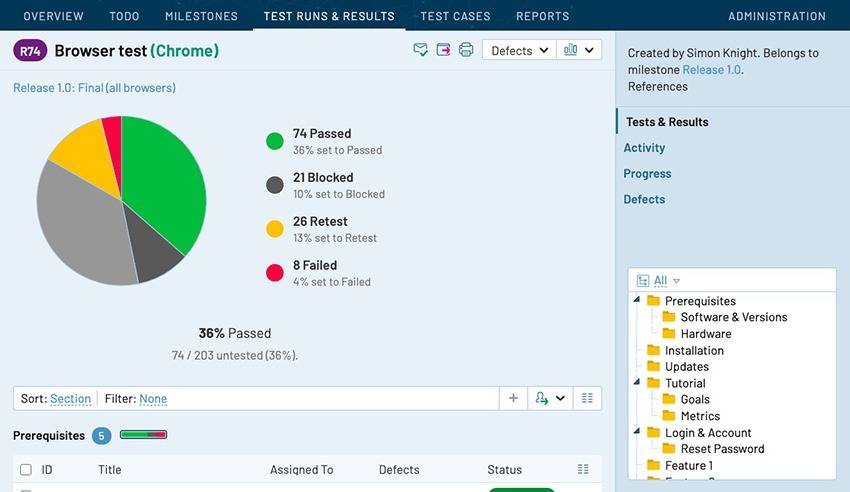
It helps you to track and manage your efforts. This tool has an intuitive web-based user interface that makes it simple to build cases, manage runs, and organize your whole process.
In addition, it simply tracks individual status, projects, and milestones with activity reports and dashboards. You can attain real-time insights into your testing progress and improve productivity with personalized email notifications, to-do lists, and filters.
Pros:
– Comprehensive case management.
– Customization features across the tool for project management and cases.
– Execution of cases.
– Interactive dashboard with real-time insights.
– Custom reporting.
– Third Party Integrations.
Cons:
– No defect management module to manage issues (requires third party integration).
– No requirements planning feature.
– No selenium integration.
– No mobile app to manage the project on the go.
10. QAComplete
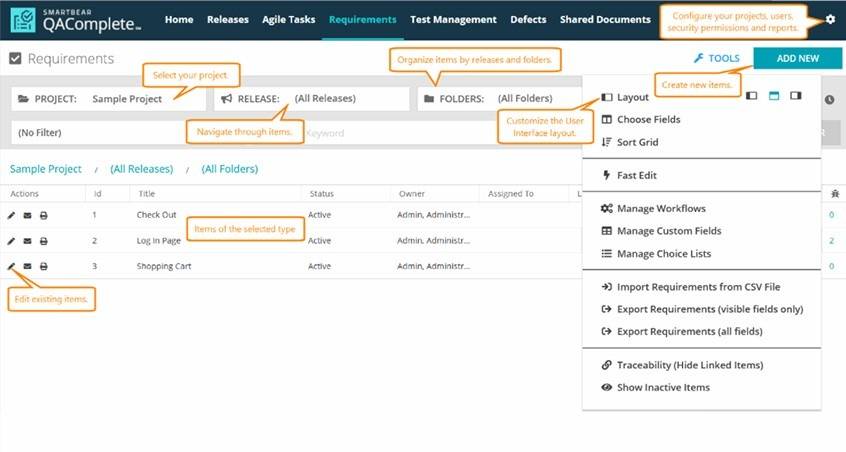
The aim of every tester is to improve the control and visibility of the processes. However, they have to spare time and resources to apply a difficult management solution or recreate the present processes to adjust a new tool.
Some of the main features include:
- Jira Management.
- Reporting both manual and automated.
- Seamless logging and bug tracking.
- Flexible management.
Pros:
– Supports Manual and Automated
– Requirements planning, bug management, case management.
– Ideal for Agile teams.
– Custom reporting.
Cons:
– No in-app support.
– No mobile app to log bugs etc.
– No SDK available for mobile app checks.
11. Zephyr
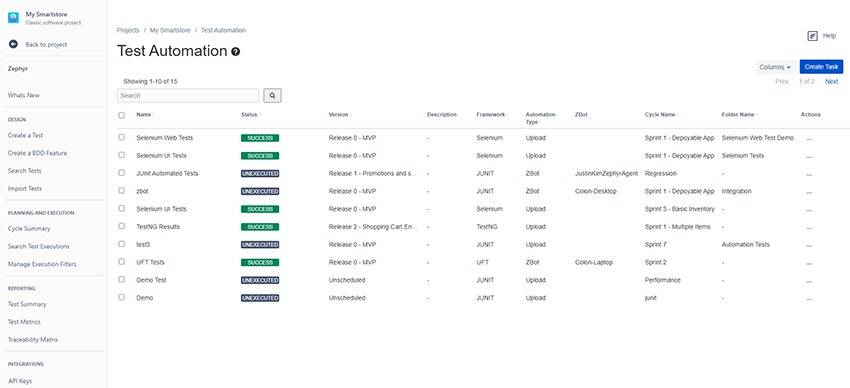
A large number of IT developers think that Jira is only a bug tracker that aims to control the development process with bugs, tasks, and agile cards. Zephyr is one of the numerous Jira plugins out spreading Jira’s capacities.
Using a combination of these two tools will enable you to attain things such as: creating test plans, cases, executing, producing reports, and more.
Pros:
– Manage all your project details from project management with best tools, issue tracking, and custom reporting all from a single tool.
– Import and Export requirements, cases, bugs, etc.
– Create, Manage and Execute Manual & Automated from a single tool.
– CI and other third party integrations including selenium.
– Mobile app to view the insights, track team’s progress, log and assign bugs on the go.
Cons:
– Expensive package of Jira and Zephyr combined.
– Limited integrations.
– No in-app support.
12. TestLink
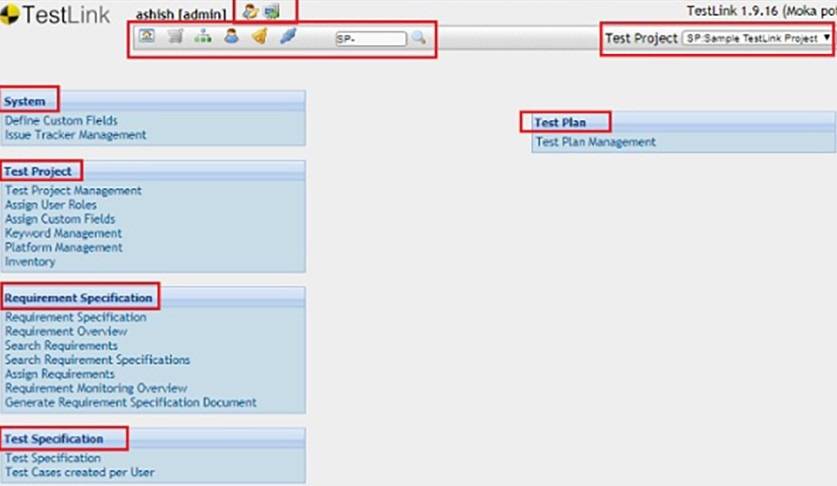
An Open-Source web-based system that is developed and maintained by Teamtest. This tool supports the quality assurance of software. The platform provides support for reports, statistics, user management, projects, plans, suites, and cases.
Pros:
– Extensive case management.
– Customization features across the tool for project management and cases.
– Execution of cases.
– Interactive dashboard with real-time insights.
– Reports feature.
Cons:
– No Defect Management module.
– Import andExport of cases and issues.
– No SDK feature for mobile app.
– No mobile app.
– Automation Support.
– No CI integration.
– Open-source tool with limited support.
13. PractiTest
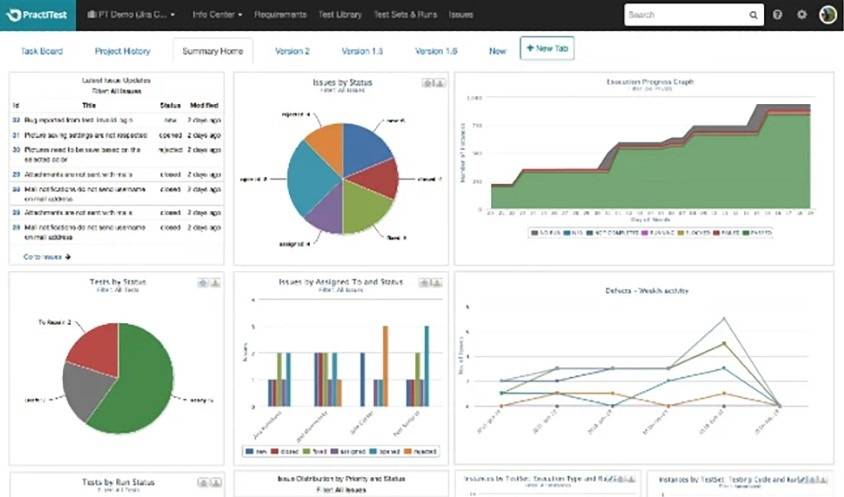
PractiTest is a cloud-based tool that offers its customers an end-to-end system to fulfill their testing and QA requirements. It is methodological, flexible, affordable, and easy to use. It enables the organization to guarantee communication and visibility at every level. It also assists project development teams to manage and organize their processes while giving management a simple and clear view of their project status every time.
Pros:
– Supports Manual and Automated Testing.
– Requirements planning, best case management tools, bug management.
– Works for Agile teams.
– Custom reporting.
Cons:
– Not budget-friendly.
– No SDK feature to support mobile app.
– No mobile app.
14. TestLodge
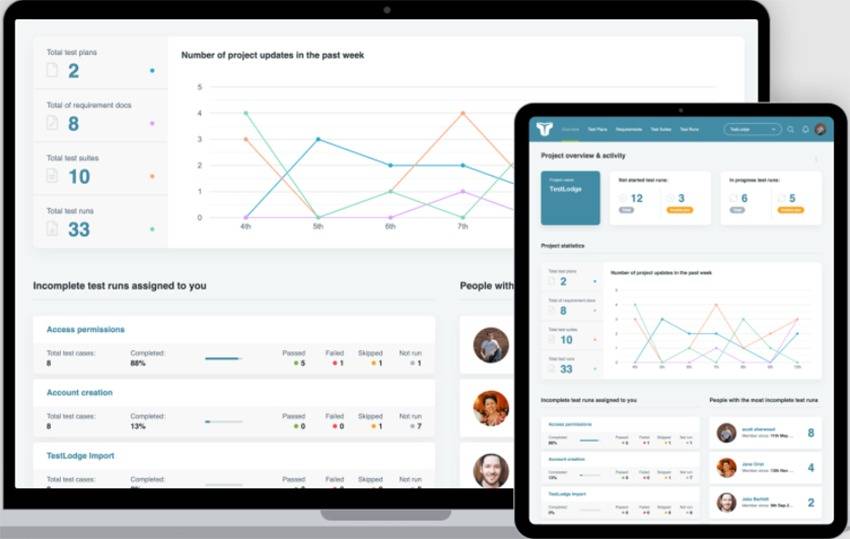
TestLodge has a standard set of functionalities by default. It syndicates with unusual button arrangements and a diverse range of varied functions. It assists you in creating a test plan, defining product requirements, gathering cases into suites, and performing checks via test runs.
In addition to the above, it enables customization of standard fields regarding runs and cases. It provides an opportunity to create priorities, categories, roles, select important parameters portrayed in the export settings, graphics. Furthermore, you will be in the circle on the activity page and project overview.
Pros:
– Requirements Planning feature to associate cases and traceability.
– Import and Export feature for cases.
– Custom reporting.
Cons:
– No defect management module to manage issues (requires third party integration).
– No CI integration.
– No automation support or selenium integration.
– No mobile app to manage projects on the go.
15. ReQtest
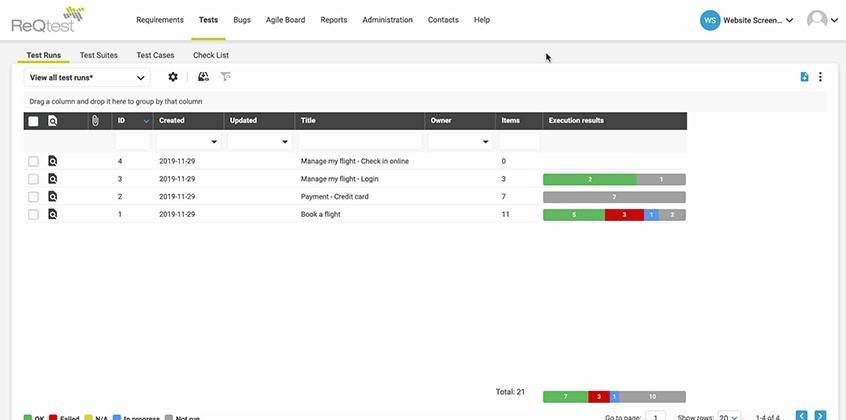
ReQtest is a cloud-hosted tool. It is used for agile project management, requirements management, and bug tracking. Its main features include an agile board, bug tracking module, requirements management module, management module, hosting, and support via phone, chat, and email. It integrates with Jira.
Pros:
– Easy to learn for users with varied experience as everyone starts at their own levels and builds up the process progressively.
– As it is cloud-based, it can be accessed from any web browser at any time.
– Gives a visual presentation of bug reports giving a comprehensive account of bugs and issues.
– Its modules are easy to use for writing and executing cases.
– Helps in collaboration between different roles – e.g. testers, developers, managers.
– Has built-in filters to find specific bugs.
– Easy to add fields and columns as per need.
– Possible to add audio and videos to bug reports.
– The agile board can be linked to requirements, bugs, and cases.
Cons:
– Dfficult to see the differences between cases due to restricted access to tests.
–Cumbersome to set up.
– Does not have SDK features.
– Does not support mobile app .
16. Klaros Test Management
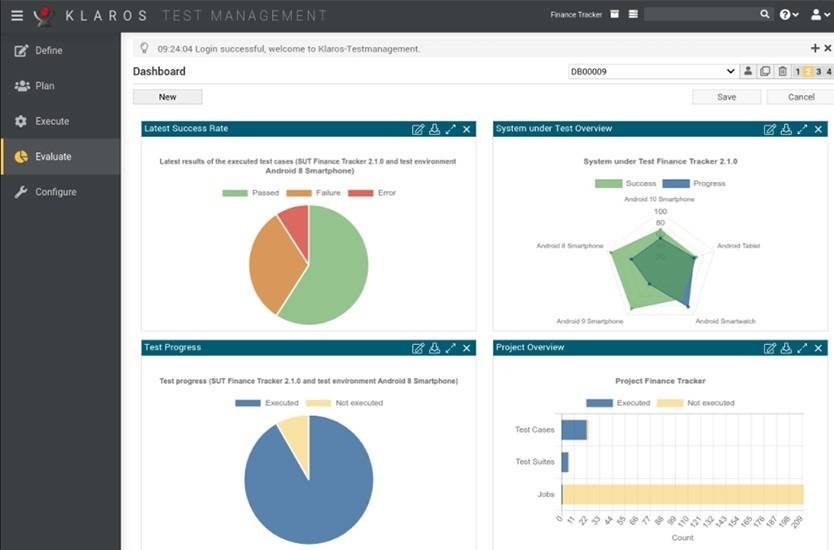
Klaros Test Management is a tool that helps one to plan, control and document the entire process. It supports tools, requirements management, defect management, agile and classical processes, coordination, documentation, reporting, integration, import, and export.
Pros:
– Allows monitoring the progress of projects at any given time.
– Easy to create and assign tasks to testers, as they are generated automatically by one push of a button.
– Reduces maintenance costs through reusable procedures, as it can be configured in many ways.
– Friendly user interface; navigating through the features is easy.
– Supports agile models like V-Modell, Scrum, and Kanban.
– Easy to trace requirements.
– Integrates easily with other automation tools, existing workflows, and integration servers.
– Gives real-time access to graphical reports.
– Easy to customize reports according to requirements.
– Training, email, and phone support is available.
Cons:
– Does not support many languages.
– Does not have a feature for live support.
– Does not have SDK features for mobile app crash reporting.
17. Testpad
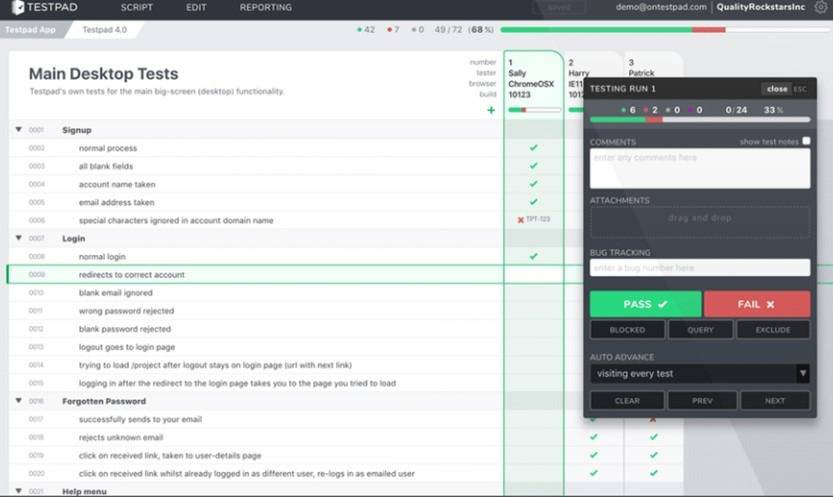
Testpad is an online tool used for both large and small projects. It uses a natural and easy-to-learn checklist-style approach, enabling quicker writing and running. As documenting time is minimized, time is maximized. Users get an at-a-glance view of the plan, their progress, and the next goal. The tool allows importing from other applications, automatic saving of changes, running with custom data and other requirements, and bug detection.
Pros:
– The checklist format is useful for agile processes as writing, rewriting, chopping, and changing is easy to organize alongside product development.
– It gives the option to tag , by which you can include or exclude groups from running.
– It can be watched on mobile with a bar code shortcut, unlike some other tools.
– The tool allows grouping into projects and building templates. It is then easy to share live progress reports with team players via links. You can write comments easily alongside scripts and results.
Cons:
– There is a need for wording better. If a new bug comes up, its indication is not portrayed well.
– Does not support automation.
– Does not have an SDK feature for mobile app crash reporting.
18. Test Collab
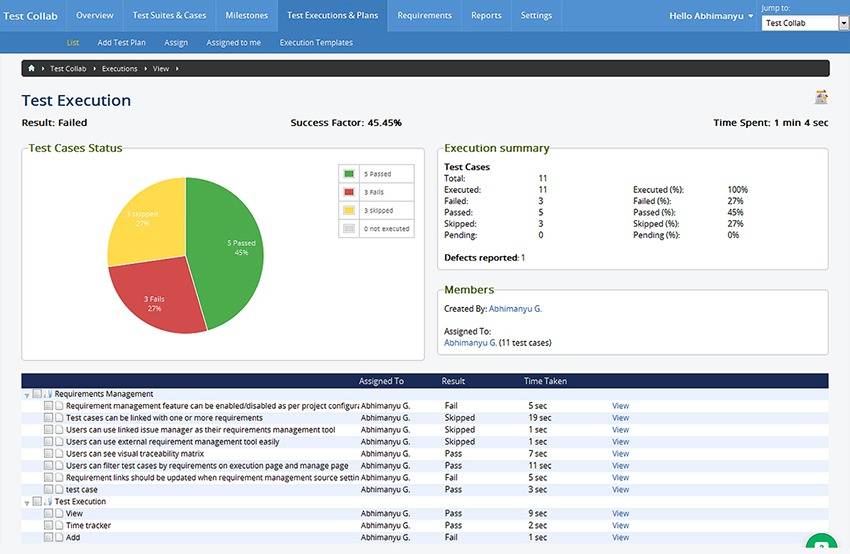
It is a tool with features like automation and requirements management. It supports dashboards, executions, intelligent reporting, and integrations. Other unique features include reusable steps, time tracker, milestones, team collaboration, and revision history.
Pros:
– Can be operated on multiple platforms – the tool’s cloud or user’s own infrastructure.
– No learning curve. Managers, leads, and developers can all use it easily.
– Easy to assign new tasks.
– You can see all your cases in one place with their full history, changelog, and versions.
– Gives insightful metrics on what was tested, as well as the results.
– Feedback cycles are speeded up by integration with the issue manager.
– The user interface is attractive with a nice color scheme.
– For hosted users, data is automatically backed up.
Cons:
– The user interface has a separate screen for execution, which makes the user experience less comfortable. The screen can be disabled. However, users are not immediately aware of the process of disabling i.e. request the account administrator on settings.
– Navigation between cases and product listing is not convenient.
– Does not support mobile app.
– No SDK support.
19. QA Coverage
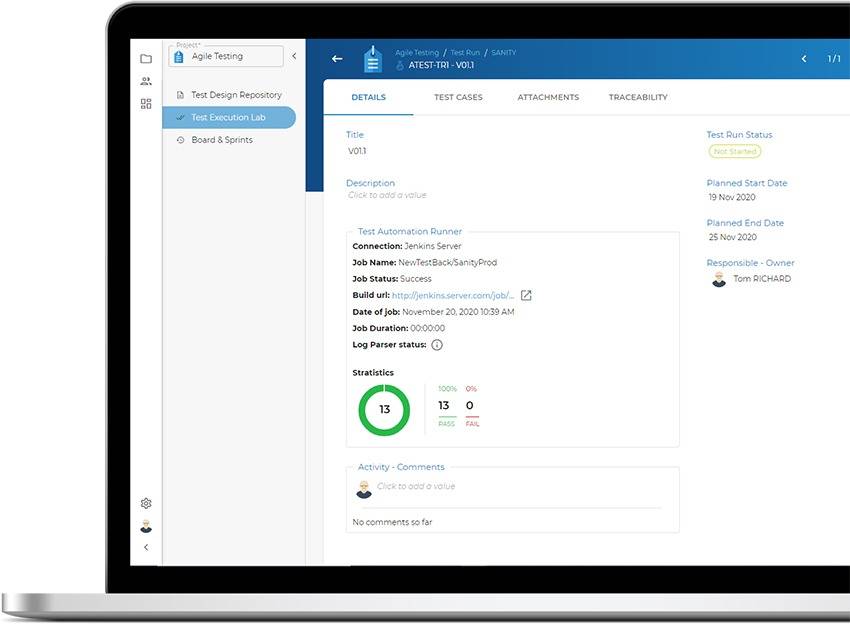
QA Coverage is one of the best tools and is a management solution for the complete and efficient management of the life cycle. It supports requirements management, design, execution, defect management, metrics, reporting modules, tickets, and agile methodology. With these features, both QA people and managers gain full visibility of the QA process from requirements inception to sprint archives.
Pros:
– Available both on cloud and on-prem solution.
– Initial and regression are easy to plan and execute because of a streamlined repository.
– Supports faster workflows with the agile module.
– Requirements, cases, and defects are easy to trace because of the requirements module.
– The workflow is simple yet detailed.
– It encourages risk-based checks and peer review.
Cons:
– Its range of integration concerning learning is small. Users may get confused about what features to use next after the first.
– There is no SDK.
– Does not support mobile app .
– No support for member roles or custom roles.
Verdict
All the tools discussed above have their own unique features that will give your QA team the advantages it requires to streamline its test cases. We advise you to carefully consider the pros and cons of each testing tool, to decide which tool is the best-suited for your needs. Investing in robust software test case management tools ensures organized and systematic tracking of cases. A reliable tool ensures that all cases are systematically tracked and easily accessible for QA teams. If you don’t want to buy it straight away, try that tool for free, and if it is to your liking and addresses your needs, you can proceed to buy the pro version. If not, then try another one for free and repeat the abovementioned process. Happy exploring!






















